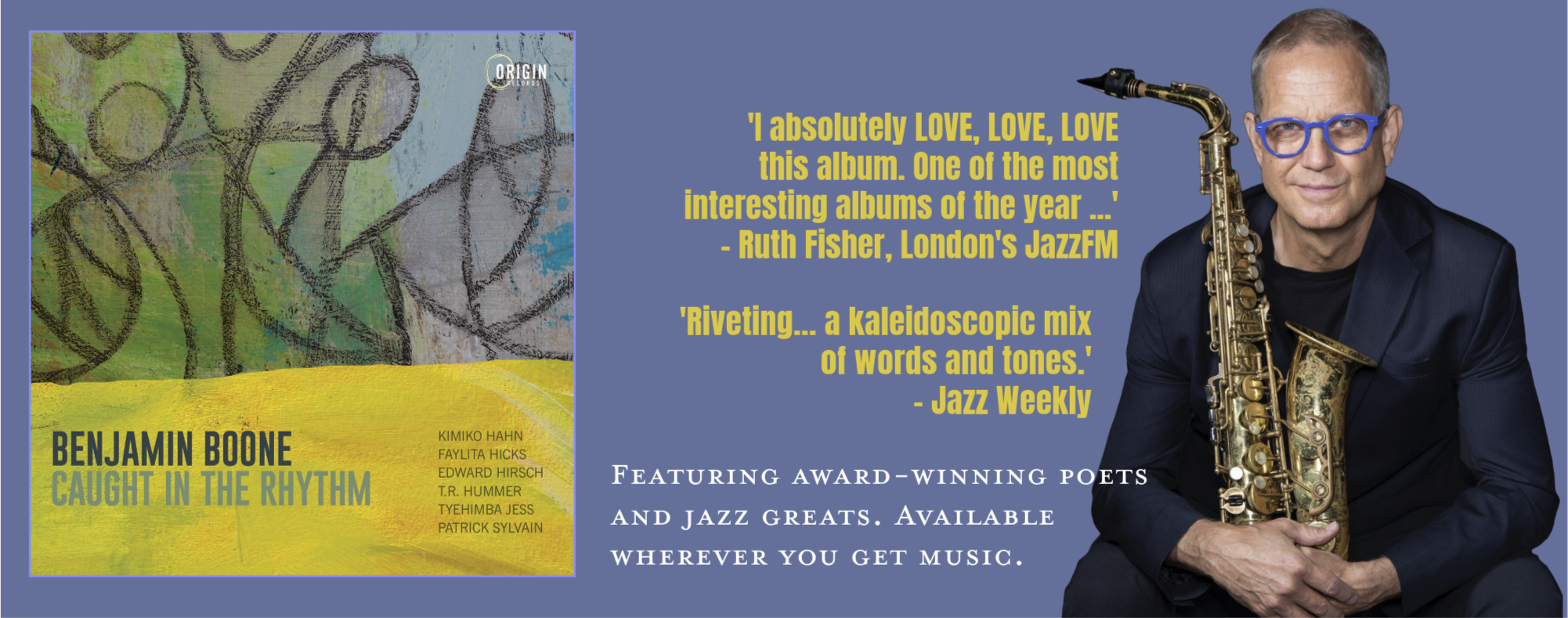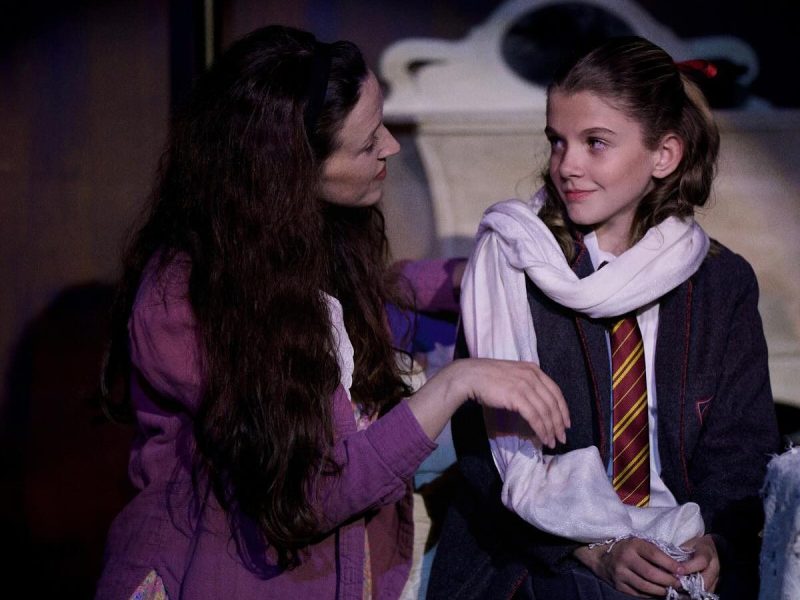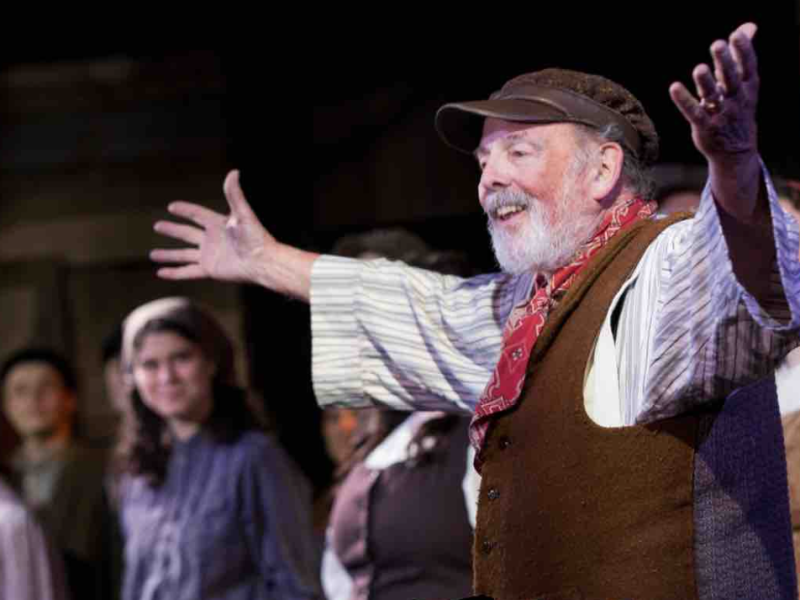THEATER REVIEW: Powerful, flawed and filled with hope, Fresno State’s ‘RENT’ includes a stunning performance by Jimmy Haynie
It’s a few days later, and my theater high from Jimmy Haynie’s cataclysmic performance as Tom Collins in Fresno State’s “RENT” still lingers.
Pictured above: Kathryn Deanna Andres, Jimmy Haynie and Luke Robert Nothstein in a scene from “RENT.” Photo: Fresno State
I’ve seen the show three times in its professional incarnation — including the original Broadway production — and the emotional sonic boom Haynie creates with his song “I’ll Cover You” ranks up there with among the most effective moments I’ve witnessed in a live production of the show. Near the end of the song — which Collins sings during a funeral– a choked-up Haynie rips off his glasses in a swoop, plants his feet on the stage, squares off against the audience, and immerses us in his sorrow. His deep, resonant voice fills the John Wright Theatre with an urgency that rattled my bones. In a musical overstuffed with trauma and loss, Haynie spins the emotion meter to the max, giving the audience a much-needed, cathartic release.
Pictured above: Jimmy Haynie plays Tom Collins in the Fresno State production of ‘RENT.’ Photo: Fresno State
It’s a stirring highlight of this ambitious and motivated student production.
Because this is a student cast, I don’t hold the performances — and particularly the vocals — to the same standards as a professional production, which is the only way I’ve seen Jonathan Larson’s “RENT” up to this point. (Though, as I’ve already indicated, Haynie is impressive by any rubric.) Watching the show, I was reminded just how tough it really is to play in “RENT.” The rock vocals soar, and soar, and soar. There’s no hiding. Add to that an operatic undercurrent of love and loss at supercharged levels, and you basically have a nearly three-hour outing that involves a tremendous amount of heavy emotional lifting. I salute this cast for inhabiting these characters fully, unequivocally, and with an intensity that burns. When one of the characters sings, sadly, “I can’t believe this family will die,” I felt the pang of real, honest, familial bonds being torn asunder.
I’d like to give an overall enthusiastic nod, as well, to director J. Daniel Herring for helping make this material feel relevant to a new generation, 25-ish years after “RENT” hit the Broadway stage.
At the same time, I have some strong reservations about the scenic and lighting designs.
Some specific thoughts about the Fresno State production, which closes May 14:
The acting: Very strong overall. Each of the eight principal performers connects with their characters in interesting and moving ways. Among them, Luke Robert Nothstein gives his Roger — the reclusive wannabe rock star — a taut, angsty, angry exterior that nonetheless softens when the possibility of love arises. Josh Plowman, as Mark, finds a boyish, teacher’s-pet tartness that makes the character’s whininess more endearing. Andrew B. Mickelson gets in some nice yuppie licks as Benny, the “traitor” now demanding rent from his former roommates. Alexis Elisa Macedo finds a radiance in Mimi, the junkie on a downward trajectory, that is deeply affecting.
The vocals: Not quite as strong overall. For me, the standouts include Kathryn Deanna Andres’ Maureen, whose “Over the Moon” performance piece is a peppy comic and vocal achievement. Julia Isabella Prieto sounds wonderful as the uptight Joanne. And Jason Bionda’s sweet falsetto anchors a tender and memorable performance as Angel Dumott Schunard, the drag queen who changes Collins’ life.
The ensemble: I enjoyed how much the performers seem connected to each other. Among my favorites: I Adeficha as a homeless person (and others), Cady Mejias as the coat vendor (and others), and Nwachukwu as Alexi Darling (and others).
The sound design: All-important for a musical, I’m happy to say that Liz Crifasi’s sound design is exceptional, particularly in making sure the audience can comprehend the lyrics. I have never understood the words to “RENT” so well as in this production. Yes, there were a couple of wobbles for me in terms of sound, including the first time we hear “Another Day,” and it’s always going to be hard to understand a song like “Christmas Bells” with its multiple lyrics on top of each other. But, overall, I was almost stunned at how easily the words came through.
The Munro Review has no paywall but is financially supported by readers who believe in its non-profit mission of bringing professional arts journalism to the central San Joaquin Valley. You can help by signing up for a monthly recurring paid membership or make a one-time donation of as little as $3. All memberships and donations are tax-deductible.
The music: However, the overall musical accompaniment seemed timid to me. The experience lacks the brash, rock-concert excess that I associate with “RENT.” There is no wall of sound to crash and jangle. On the positive side, you get those wonderfully understandable lyrics (see above). But I do think “RENT” is also about the vibration of the music. The four-piece pit orchestra (under the direction of Jordan Williams) sounds just fine, but without the sheer, acrid weight of those heavy guitar chords, the production can feel more like a dainty chamber musical.
The scenic design: I don’t get it. Jeff Hunter has framed the action — which takes place in the near-slum of Alphabet City on the East Side of Manhattan — with two imposing Roman-style columns flanking each side of the stage. There are some flyers plastered on the columns at street level, indicating a level of urban hipness, but the whole thing feels like you’ve walked into the Parthenon. Upstage (the rear of the stage from the audience’s perspective) is a classical-style bunched drapery — but just half of it. In the distance are some sort of flats (or perhaps a building?) propped up against the wall. The set itself, meanwhile, is a clumpy wooden two-story structure.
So. Many. Questions. Are we supposed to be evoking ancient Rome with all the neo-classical allusions? Frankly, all the elements are here for a painting by Jacque-Louis David, right down to the faintest of architectural ruins in the distance. But what does Rome have to do with “RENT”? I suppose if you’re trying for a classical feel, you could make a connection in some way to Paris because of “La Boheme.” But Paris is not Rome.
Related story: 25 YEARS AFTER THE GROUNDBREAKING ROCK MUSICAL OPENED, IT’S TIME FOR THESE FRESNO STATE STUDENTS TO START PAYING ‘RENT’
Plus: What’s up with all that wood? Instead of the gritty, urban, throwback-to-Steampunk vibe I think of for “RENT,” the natural-color wood and visual ponderousness of the set makes it feel more like the interior of a Bass Pro Shop than a 100-year-old-plus decaying factory or warehouse. Even if it had to be wood for some hyper-specific California State University safety rule, couldn’t it have been painted black? Perhaps I am missing some big, obvious, major reason why Hunter and the rest of those involved made these creative choices, but I’m perplexed.
The lighting design: For much of the show, Regina Harris’ lighting is inconsequential, and that’s too bad. A scene in a darkened room with the power out? There’s barely a representation of that. (We have to be able to see the actors, of course, but there are ways to do that and still convey the sense of darkness.) Very few of the belt-it-out-numbers are lighted in a way that complement the singers emotionally. Not until we get to Maureen’s big “Over the Moon” number in the first act does the lighting ever seem vigorous. Lighting-wise, “RENT” should have the swagger and bombast of a concert, the heightened intensity of an opera, and the nuance of a searing Shakespearean tragedy. This show doesn’t.
The staging: Herring offers some very nice moments, and he mixes things up a bit from the Broadway version — such as adding members of the ensemble to such songs as “Out Tonight” and “Tango Maureen.” I like the way he dispensed with a long table in “La Vie Boheme” and scattered the actors around the stage more, putting them more into the forefront as the crazy lyrics unfold. I’m not keen about a couple of things: “Contact,” the safe-sex song, feels inert the way it’s staged here, with the cast standing at arm’s length; and “Your Eyes,” sung by Roger to Mimi as she shivers a few feet away from him on the ground, seemed very awkward to me. Someone get that woman a blanket!
Finally: I want to circle back around to Jimmy Haynie and Jason Bionda, whose relationship as Collin and Angel is a joyful anchor to the production. Both actors are transformed on stage — and not just because one plays a drag queen. Their chemistry crackles, and the depth of their characters is splayed out there for all to see.They somehow encapsulate how and why “RENT” is so important. It’s about human connection. “I’ll cover you,” Haynie sings — no, booms — and you realize that if more people in this world were saying that to someone, it’d be a better place.










Steph
Your review is exactly what I’d heard about this production so I’ll have to assume last night was just one of those off nights.
There were mic issues, the lyrics were tough sometimes, Mark was too quiet, and pitchy vocals abounded. One mic just crackled LOUD and a poor ensemble singer’s solo was not amplified.
You wrote how the line “I can’t believe this family must die” was so effective: Well of course it was – Haynie sings it!
As a Rent-aholic I was impressed with many elements, but J Daniel’s blocking wasn’t one of them. I get Collins and Angel are on a walk, but it’s tough to get closely engrossed in their love when they keep marching further and further away from us and up to the highest levels. I found the ensemble blocking to be very formulaic and highly dictated and removed from the main cast.
RENT is a super tough show to do under any circumstance, and like you I was thrilled to see Fresno State tackle it. They gave it one of the best directors in town, some ringers in the cast, and despite the confusing Ionic columns and wood boxes (the under budgeted HS way to go), I didn’t let the set bother me much at all.
I wish I knew the names of the standout ensemble members – the “honest living” girl was so strong as a dancer and so invested in the ensemble.
I loved Mark’s over the top playfulness. Joanne was absolutely solid and powerful. Haynie’s emotions carried him on a perhaps softer singing night, and Angel’s kind face and voice helped me see past the very healthy actor who pretty clearly wasn’t in the throes of a horrible disease. Roger was great, his singing the best at its rockstar moments, Maureen was fine, Mimi clever and playfully believable when showing her street smarts. (Plus on my second Broadway viewing Daphne Rubin-Vega was so drunk!).
All this blather to say CONGRATS to FSU for bringing out a musical! May they do many many more!
Gerald (Jerry) Palladino
Donald, I’m attending the last performance. Chet and I attended on May 7. I was heartened by the casting and performances, but I personally did feel there wasn’t the energy the musical needed. I’m giving it another try, because this Fresno State production dared to recreate the wonderment of RENT. Yes, the Tom Collins and Angel characterizations were moving standouts, but I was also deeply moved by the impressive Mark character. I saw RENT in three professional performances, and I understand your review sentiments. Hats off to my dear friend, J. Danial Herring, for bringing RENT back to the stage. His adaptation stands tall and merits applause.
Lorenzo Bassman
Donald-
I agree with a lot of your points. It was a bold move to even attempt to stage this show, considering all that it requires of even a professional company, and much more so for a student production. And I was totally taken with Jimmy Haynie’s performance and also, particularly from the ensemble, that of Nwachukwu. And I was quite moved by Jason Bionda’s acting performance. I must have been at the same performance as the commenter above who experienced the crackling of a microphone. Considering how vast the technical challenges of the audio setup are, it’s amazing that this only happened with one vocalist. All it takes is the tiniest micro-misconnection of a worn cable, even after a successful soundcheck has been performed, to cause something like this to happen.
I wanted to focus on the vocals in general. It seems like in this age in which most Broadway-musical-style singers are required to have a particular range – with both altos and tenors largely sharing the same vocal range and all straining to push up against the top of their chest voices for dramatic effect – well – I suppose if I were the music director, I might consider taking the needs of some of the vocalists in mind and transpose some of the songs down maybe a whole step or even just a half step, and this would facilitate a less strained result, but without sacrificing the dramatic effect that the composer is desiring by placing the vocal lines where they are. To me, although everyone was trying their best, a lot of the kids were just not quite there in terms of being able to handle the difficult vocal placement, which resulted in some folx just hanging a bit below the pitch enough of the time that the overall effect was unpleasant. Maybe it’s me though, and I have to admit I’m coming from a more operatic place, where there are folx who would in every day life be considered altos except for the fact that they actually are trained to use their head voice mostly. When they do descend down into their chest voice (and they tend to extend their head voices down as far as they can go until switching), it is often used for dramatic effect, but for the opposite effect than that used here in this musical and in a lot of others these days. You just don’t get a lot of Emile de Becque true baritone roles these days, for example. Fortunately, for Jimmie Haynie’s sake, his solos did not require him to go beyond his comfort range.
But mostly I’m glad that J. Daniel Herring decided to take this on, because these are students after all, and what they are in school for is not to be asked to do what they can comfortably do, but to be challenged to go beyond what they can comfortably do. Performing Arts students are some of the few who actually understand that.